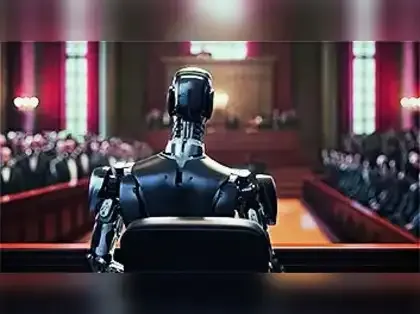Earlier this week, after being sworn in as 53rd CJI, Surya Kant talked about how 'a scientific and comprehensive approach is essential to address the challenge of pendency across all tiers of the judiciary'. He had earlier observed that 'the judiciary has begun exploring AI-based tools for research, transcription, and data analytics, always with the guiding principle that technology must augment, not replace, the human mind's discernment', adding that 'the law, after all, is not a mere algorithm - it is the reflection of human conscience shaped by empathy, moral reasoning, and an understanding of context that machines cannot replicate'.
While there is a greater degree of consensus that has already enabled use technology in our courts, its scope, content, context, contours and impact are up for debate and discussion.
The most compelling case for the use of AI in courts is in relation to massive pendency. The sheer scale of the number of cases stuck in courts - more than 5 cr - is daunting. A digitally-enabled judiciary already includes the e-Courts project and National Judicial Data Grid. They can serve as a foundation. But they are woefully inadequate to clear the huge pile-up in a time-bound manner.
Making AI a significant part of adjudication requires recognising causes for delays, and for insufficient impact of technology so far. Procedural delays, insufficient administrative capacity, increased dependency on manual paperwork, high levels of inefficient case scheduling, and limited access for citizens are some of major reasons. Out of the 5 cr-plus cases pending, a large number are in district and subordinate courts (above 4.3 cr), compared to those in the Supreme Court (80,000) and high courts (60 lakh). Hence, AI-enabled and tech-driven reforms need to be democratised significantly with a strong emphasis on lower courts.
5 areas of AI use and adaptation within the judicial context can be considered:
Case management & scheduling There should be a focus on developing automated cause lists using machine-learnt predictions, and real-time and dynamic scheduling to reduce adjournments.
Natural language-processing tools for document processing This includes, but is not limited to, document classification, translation, summarisation, AI-assisted drafting for routine orders, notices, bail formats, and speech-to-text for court transcription and translation in real time.
Virtual courts, remote and hybrid hearings These need to go beyond traffic challans. There is a case for AI-supported digital kiosks for litigants across rural India. AI-based adaptive, and generative legal research should be undertaken for basic matters like precedent search, extraction of ratios, lines of reasoning, and flagging conflicting precedents or overruled cases.
Blockchain For evidence and court records, blockchain tech can enable the administrative apparatus to ensure tamper-proof digital evidence storage and chain-of-custody verification. More targeted technologies to spot deepfakes is also needed. This will save significant time and improve court efficiency, which has a direct bearing on addressing administrative delays.
Analytics Real-time backlog analytics and judicial productivity dashboards can help significantly. But one must ensure that every idea relating to AI use in courts is subject to fundamental and non-negotiable principles of transparency, accountability and ethical compliance.
A 2023 Harvard Kennedy School paper, 'AI, Judges and Judgement: Setting the Scene', observes, '...some public scepticism of AI's extension in the courtroom is useful in ensuring algorithms remain accountable and fair. The performance of models can be overhyped and exaggerated, amplifying a common misconception that these algorithms always surpass human-level reasoning. There is a fine balance to strike - once AI justice is inevitably and gradually improved - in boosting popular confidence in these tools while tempering unrealistic expectations of their capabilities.'
The new CJI should evaluate the options and opportunities for considering AI use in courts to develop a technology-enabled judiciary. There is a case for establishing a national task force chaired by Kant with judges, lawyers, government officials, tech experts and academics to develop a white paper to build awareness and chart the course for action.
While there is a greater degree of consensus that has already enabled use technology in our courts, its scope, content, context, contours and impact are up for debate and discussion.
The most compelling case for the use of AI in courts is in relation to massive pendency. The sheer scale of the number of cases stuck in courts - more than 5 cr - is daunting. A digitally-enabled judiciary already includes the e-Courts project and National Judicial Data Grid. They can serve as a foundation. But they are woefully inadequate to clear the huge pile-up in a time-bound manner.
Making AI a significant part of adjudication requires recognising causes for delays, and for insufficient impact of technology so far. Procedural delays, insufficient administrative capacity, increased dependency on manual paperwork, high levels of inefficient case scheduling, and limited access for citizens are some of major reasons. Out of the 5 cr-plus cases pending, a large number are in district and subordinate courts (above 4.3 cr), compared to those in the Supreme Court (80,000) and high courts (60 lakh). Hence, AI-enabled and tech-driven reforms need to be democratised significantly with a strong emphasis on lower courts.
5 areas of AI use and adaptation within the judicial context can be considered:
Case management & scheduling There should be a focus on developing automated cause lists using machine-learnt predictions, and real-time and dynamic scheduling to reduce adjournments.
Natural language-processing tools for document processing This includes, but is not limited to, document classification, translation, summarisation, AI-assisted drafting for routine orders, notices, bail formats, and speech-to-text for court transcription and translation in real time.
Virtual courts, remote and hybrid hearings These need to go beyond traffic challans. There is a case for AI-supported digital kiosks for litigants across rural India. AI-based adaptive, and generative legal research should be undertaken for basic matters like precedent search, extraction of ratios, lines of reasoning, and flagging conflicting precedents or overruled cases.
Blockchain For evidence and court records, blockchain tech can enable the administrative apparatus to ensure tamper-proof digital evidence storage and chain-of-custody verification. More targeted technologies to spot deepfakes is also needed. This will save significant time and improve court efficiency, which has a direct bearing on addressing administrative delays.
Analytics Real-time backlog analytics and judicial productivity dashboards can help significantly. But one must ensure that every idea relating to AI use in courts is subject to fundamental and non-negotiable principles of transparency, accountability and ethical compliance.
A 2023 Harvard Kennedy School paper, 'AI, Judges and Judgement: Setting the Scene', observes, '...some public scepticism of AI's extension in the courtroom is useful in ensuring algorithms remain accountable and fair. The performance of models can be overhyped and exaggerated, amplifying a common misconception that these algorithms always surpass human-level reasoning. There is a fine balance to strike - once AI justice is inevitably and gradually improved - in boosting popular confidence in these tools while tempering unrealistic expectations of their capabilities.'
The new CJI should evaluate the options and opportunities for considering AI use in courts to develop a technology-enabled judiciary. There is a case for establishing a national task force chaired by Kant with judges, lawyers, government officials, tech experts and academics to develop a white paper to build awareness and chart the course for action.
(Disclaimer: The opinions expressed in this column are that of the writer. The facts and opinions expressed here do not reflect the views of www.economictimes.com.)









C Raj Kumar
The writer is founding vice-chancellor, OP Jindal Global University, Haryana